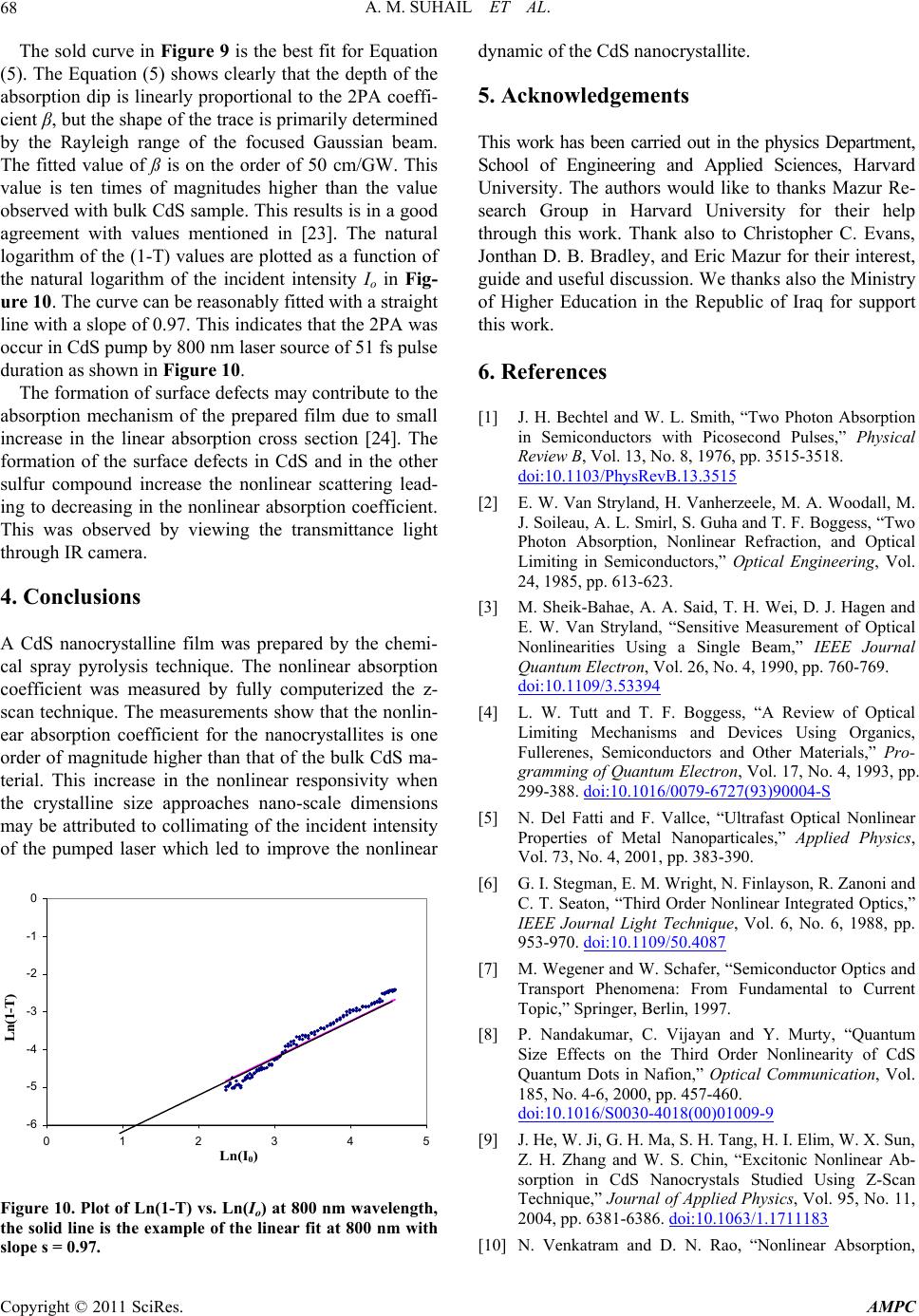
A. M. SUHAIL ET AL.
68
The sold curve in Figure 9 is the best fit for Equation
(5). The Equation (5) shows clearly that the depth of the
absorption dip is linearly proportional to the 2PA coeffi-
cient β, but the shape of the trace is primarily determined
by the Rayleigh range of the focused Gaussian beam.
The fitted value of ß is on the order of 50 cm/GW. This
value is ten times of magnitudes higher than the value
observed with bulk CdS sample. This results is in a good
agreement with values mentioned in [23]. The natural
logarithm of the (1-T) values are plotted as a function of
the natural logarithm of the incident intensity Io in Fig-
ure 10. The curve can be reasonably fitted with a straight
line with a slope of 0.97. This indicates that the 2PA was
occur in CdS pump by 800 nm laser source of 51 fs pulse
duration as shown in Figure 10.
The formation of surface defects may contribute to the
absorption mechanism of the prepared film due to small
increase in the linear absorption cross section [24]. The
formation of the surface defects in CdS and in the other
sulfur compound increase the nonlinear scattering lead-
ing to decreasing in the nonlinear absorption coefficient.
This was observed by viewing the transmittance light
through IR camera.
4. Conclusions
A CdS nanocrystalline film was prepared by the chemi-
cal spray pyrolysis technique. The nonlinear absorption
coefficient was measured by fully computerized the z-
scan technique. The measurements show that the nonlin-
ear absorption coefficient for the nanocrystallites is one
order of magnitude higher than that of the bulk CdS ma-
terial. This increase in the nonlinear responsivity when
the crystalline size approaches nano-scale dimensions
may be attributed to collimating of the incident intensity
of the pumped laser which led to improve the nonlinear
-6
-5
-4
-3
-2
-1
0
012345
Ln(1-T)
Ln(I
0
)
Figure 10. Plot of Ln(1-T) vs. Ln(Io) at 800 nm wavelength,
the solid line is the example of the linear fit at 800 nm with
slope s = 0.97.
dynamic of the CdS nanocrystallite.
5. Acknowledgements
This work has been carried out in the physics Department,
School of Engineering and Applied Sciences, Harvard
University. The authors would like to thanks Mazur Re-
search Group in Harvard University for their help
through this work. Thank also to Christopher C. Evans,
Jonthan D. B. Bradley, and Eric Mazur for their interest,
guide and useful discussion. We thanks also the Ministry
of Higher Education in the Republic of Iraq for support
this work.
6. References
[1] J. H. Bechtel and W. L. Smith, “Two Photon Absorption
in Semiconductors with Picosecond Pulses,” Physical
Review B, Vol. 13, No. 8, 1976, pp. 3515-3518.
doi:10.1103/PhysRevB.13.3515
[2] E. W. Van Stryland, H. Vanherzeele, M. A. Woodall, M.
J. Soileau, A. L. Smirl, S. Guha and T. F. Boggess, “Two
Photon Absorption, Nonlinear Refraction, and Optical
Limiting in Semiconductors,” Optical Engineering, Vol.
24, 1985, pp. 613-623.
[3] M. Sheik-Bahae, A. A. Said, T. H. Wei, D. J. Hagen and
E. W. Van Stryland, “Sensitive Measurement of Optical
Nonlinearities Using a Single Beam,” IEEE Journal
Quantum Electron, Vol. 26, No. 4, 1990, pp. 760-769.
doi:10.1109/3.53394
[4] L. W. Tutt and T. F. Boggess, “A Review of Optical
Limiting Mechanisms and Devices Using Organics,
Fullerenes, Semiconductors and Other Materials,” Pro-
gramming of Quantum Electron, Vol. 17, No. 4, 1993, pp.
299-388. doi:10.1016/0079-6727(93)90004-S
[5] N. Del Fatti and F. Vallce, “Ultrafast Optical Nonlinear
Properties of Metal Nanoparticales,” Applied Physics,
Vol. 73, No. 4, 2001, pp. 383-390.
[6] G. I. Stegman, E. M. Wright, N. Finlayson, R. Zanoni and
C. T. Seaton, “Third Order Nonlinear Integrated Optics,”
IEEE Journal Light Technique, Vol. 6, No. 6, 1988, pp.
953-970. doi:10.1109/50.4087
[7] M. Wegener and W. Schafer, “Semiconductor Optics and
Transport Phenomena: From Fundamental to Current
Topic,” Springer, Berlin, 1997.
[8] P. Nandakumar, C. Vijayan and Y. Murty, “Quantum
Size Effects on the Third Order Nonlinearity of CdS
Quantum Dots in Nafion,” Optical Communication, Vol.
185, No. 4-6, 2000, pp. 457-460.
doi:10.1016/S0030-4018(00)01009-9
[9] J. He, W. Ji, G. H. Ma, S. H. Tang, H. I. Elim, W. X. Sun,
Z. H. Zhang and W. S. Chin, “Excitonic Nonlinear Ab-
sorption in CdS Nanocrystals Studied Using Z-Scan
Technique,” Journal of Applied Physics, Vol. 95, No. 11,
2004, pp. 6381-6386. doi:10.1063/1.1711183
[10] N. Venkatram and D. N. Rao, “Nonlinear Absorption,
Copyright © 2011 SciRes. AMPC